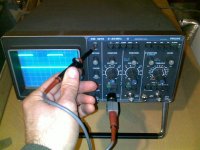I'm considering buying a used oscilloscope from the estate of an old HAM radio guy who died. I'm not very familiar with analog oscilloscopes; it's been decades since I played with them in school.
So I was wondering if the issue I noticed with this one is normal. Please see the picture in the attachment. What I found was that when viewing the calibration square wave, the horizontal lines were much more intense than the vertical lines, so much so that the vertical lines were hard to see.
I don't see this issue with my new digital storage oscilloscope, of course. Can anyone comment whether it would be possible to make the horizontal lines more visible through calibration, or adjustment of front panel controls, or is this something where different models perform differently?
I definitely know I've seen analog scopes displaying square waves where the horizontal and vertical lines are equally intense... perhaps this requires circuitry in the oscilloscope to change the intensity depending on the rate of deflection, and this scope has issues (or is missing) that circuitry?
So I was wondering if the issue I noticed with this one is normal. Please see the picture in the attachment. What I found was that when viewing the calibration square wave, the horizontal lines were much more intense than the vertical lines, so much so that the vertical lines were hard to see.
I don't see this issue with my new digital storage oscilloscope, of course. Can anyone comment whether it would be possible to make the horizontal lines more visible through calibration, or adjustment of front panel controls, or is this something where different models perform differently?
I definitely know I've seen analog scopes displaying square waves where the horizontal and vertical lines are equally intense... perhaps this requires circuitry in the oscilloscope to change the intensity depending on the rate of deflection, and this scope has issues (or is missing) that circuitry?
Attachments
There is sometimes a Z-modulation wrt to spot speed, but this can only work between limits obviously.I definitely know I've seen analog scopes displaying square waves where the horizontal and vertical lines are equally intense... perhaps this requires circuitry in the oscilloscope to change the intensity depending on the rate of deflection,
Anyway, this is one of the "features" of analog scopes: it is one of the many clues they give on a signal in addition to the waveform shape itself.
Digital scopes try to imitate it with DPO and similar tricks, but they are only moderately convincing compared to the real thing.
No fear; this is just due to the way analog scopes create the image you see.
The scope sweeps the electron beam from left to right at a specified rate (depending on the setting of your time/div dial). The vertical deflection is controlled by the input signal. So when the signal transitions in level very quickly, such as the edge of a square wave, the trace moves so quickly that hardly any electrons hit that part of the screen, so it doesn't glow much.
The scope sweeps the electron beam from left to right at a specified rate (depending on the setting of your time/div dial). The vertical deflection is controlled by the input signal. So when the signal transitions in level very quickly, such as the edge of a square wave, the trace moves so quickly that hardly any electrons hit that part of the screen, so it doesn't glow much.
What he just said.
The test signal is a square wave, the signal voltage snaps instantly from the higher to the lower voltage and back. So there is no vertical line to display, really, unless you really speed up th sweep.
COnnect it to a sine wave or music, or just touch the probe tip with your finger, and you should see a nice bright trace.
The test signal is a square wave, the signal voltage snaps instantly from the higher to the lower voltage and back. So there is no vertical line to display, really, unless you really speed up th sweep.
COnnect it to a sine wave or music, or just touch the probe tip with your finger, and you should see a nice bright trace.
- Status
- This old topic is closed. If you want to reopen this topic, contact a moderator using the "Report Post" button.
- Home
- Design & Build
- Equipment & Tools
- oscilloscope defect (?) horizontal more intense than vertical
